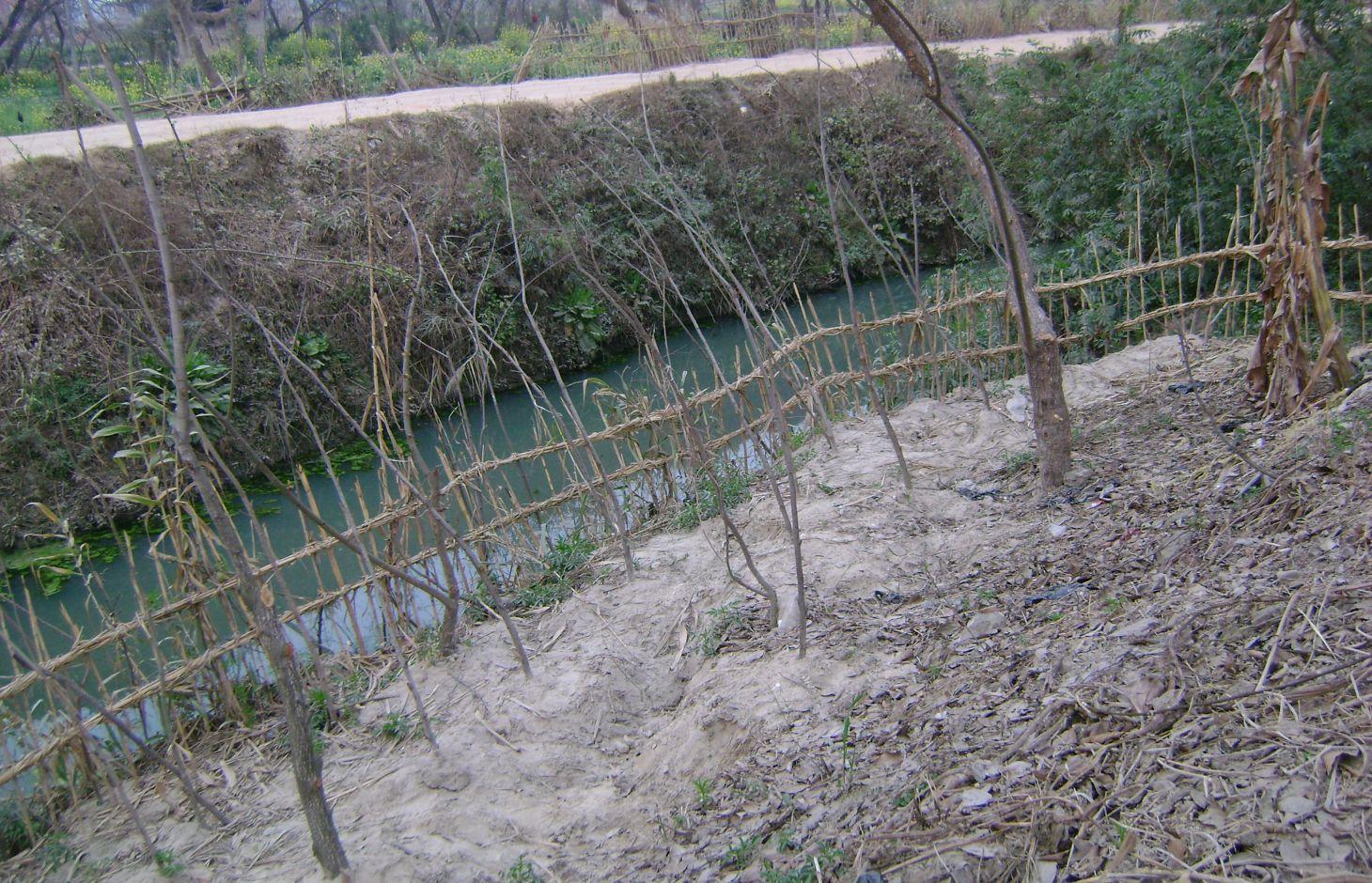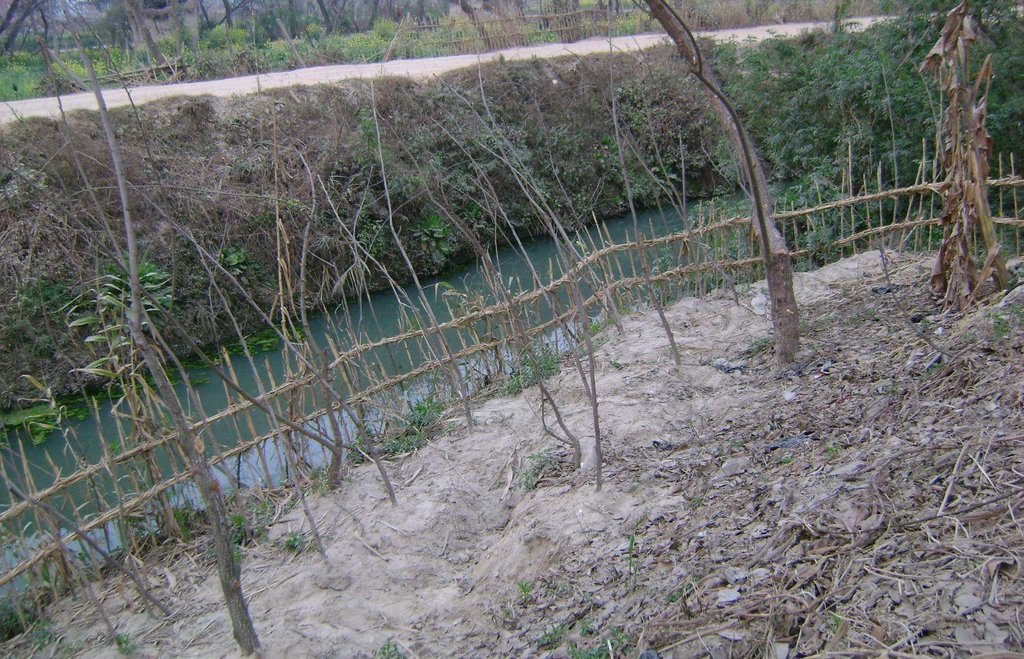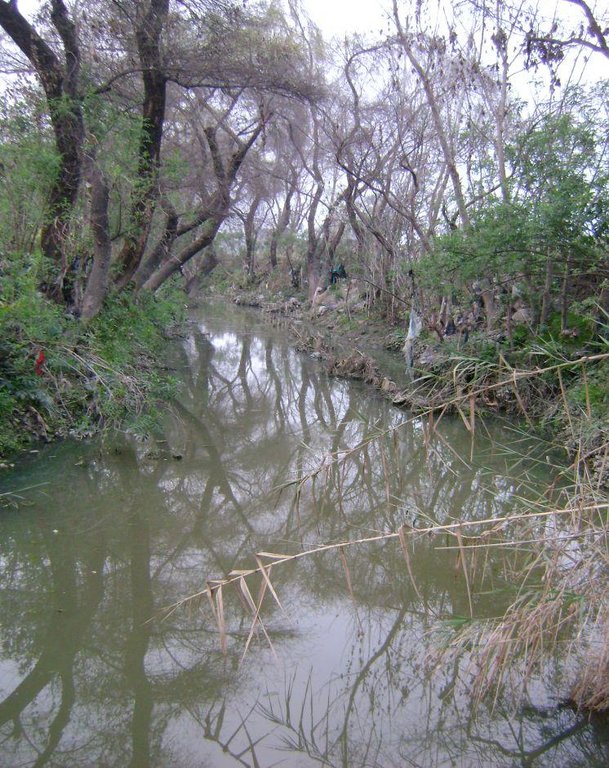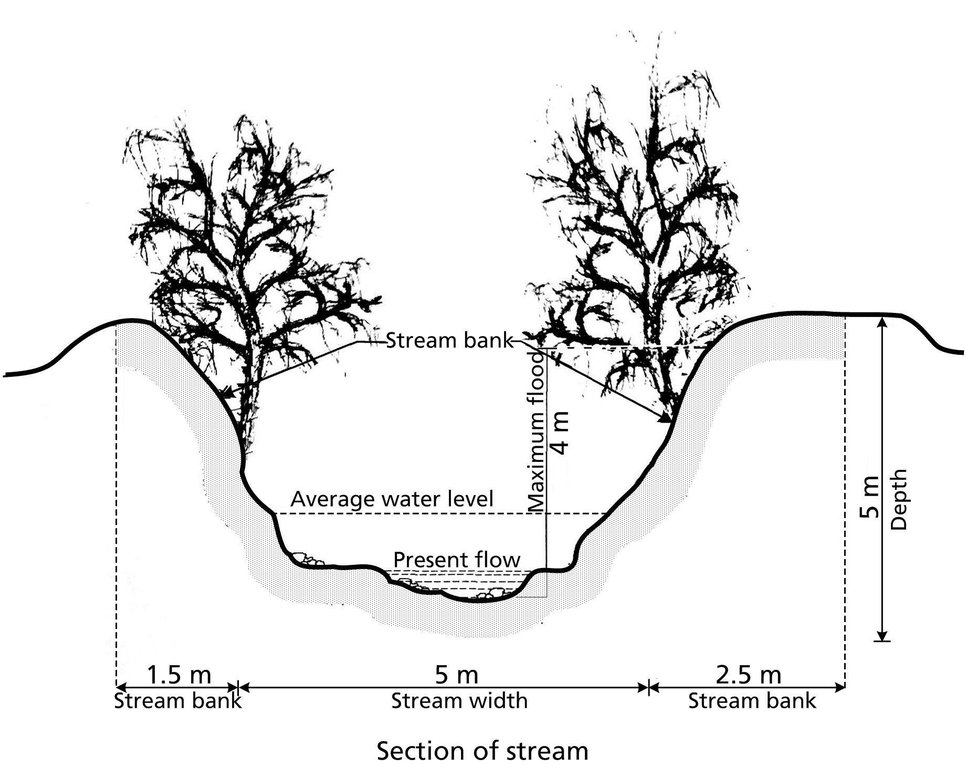Using Salix plant to protect stream banks [尼泊尔]
- 创建:
- 更新:
- 编制者: Shreedip Sigdel
- 编辑者: –
- 审查者: David Streiff, Alexandra Gavilano
Baais ropi khola kinar samrakshan
technologies_1693 - 尼泊尔
查看章节
全部展开 全部收起1. 一般信息
1.2 参与该技术评估和文件编制的资源人员和机构的联系方式
SLM专业人员:
Mulepati Indira
Department of Soil Conservation and Watershed Management
尼泊尔
有助于对技术进行记录/评估的机构名称(如相关)
Department of Soil Conservation and Watershed Mana (Department of Soil Conservation and Watershed Mana) - 尼泊尔有助于对技术进行记录/评估的机构名称(如相关)
ICIMOD International Centre for Integrated Mountain Development (ICIMOD) - 尼泊尔1.3 关于使用通过WOCAT记录的数据的条件
编制者和关键资源人员接受有关使用通过WOCAT记录数据的条件。:
是
2. SLM技术的说明
2.1 技术简介
技术定义:
Stream banks can be protected by planting them with Salix (Salix babylonica); this is a traditional practice that has been used for streams that flow through agricultural lands.
2.2 技术的详细说明
说明:
The erosion of stream banks is a natural geomorphic process, but when the streams flow through agricultural land there is a danger that they can overrun their banks and damage crops or erode land used for cultivation. The degree of erosion can be reduced by using structural measures such as lining the banks with concrete or large boulders or by planting trees along the edges. The Salix plant (Salix babylonica) has been found to be particularly useful for preventing erosion because its roots extend deep into the soil and help to anchor the bank. Following age-old tradition, land users in Bhaktapur district have planted Salix along the Bramayaeni khola (stream). It is a low-cost technology that is simple to implement.
Purpose of the Technology: Salix does best in moist soils, such as those found along irrigation channels and along the banks of rivers and streams. Salix saplings are most commonly planted in single rows but sometimes in double rows. After the saplings are planted, the entire area is fenced off using a biofence to protect them from being eaten or trampled by wild animals. Land users keep an eye on the Salix and prune or thin them as needed, for example when it is shading crops, or when they need firewood or can sell the branches.
2.3 技术照片
2.5 已应用该技术的、本评估所涵盖的国家/地区/地点
国家:
尼泊尔
有关地点的进一步说明:
Bhaktapur Municipality-2, Nantukucha, Bhaktapur District
具体说明该技术的分布:
- 适用于特定场所/集中在较小区域
注释:
Total area covered by the SLM Technology is 0.026 km2.
3. SLM技术的分类
3.1 该技术的主要目的
- 减少、预防、恢复土地退化
3.2 应用该技术的当前土地利用类型

农田
- 一年一作
每年的生长季节数:
- 2
注释:
Major land use problems (compiler’s opinion): When streams overflow their banks, agricultural land can be flooded and eroded.
3.5 该技术所属的SLM组
- 改良植物品种/动物品种
- 地表水管理(泉、河、湖、海)
3.6 包含该技术的可持续土地管理措施

植物措施
- V1:乔木和灌木覆盖层
3.7 该技术强调的主要土地退化类型

土壤水蚀
- Wr:河岸侵蚀
注释:
Main causes of degradation: floods
3.8 防止、减少或恢复土地退化
具体数量名该技术与土地退化有关的目标:
- 防止土地退化
4. 技术规范、实施活动、投入和成本
4.1 该技术的技术图纸
技术规范(与技术图纸相关):
Schematic diagram of a low cost riverbank protection scheme that can be implemented using mostly local materials.
Technical knowledge required for land users: moderate
Main technical functions: The Salix roots reinforce the soil and support it by buttressing and arching., Salix armours the slope against surface erosion
Secondary technical functions: Floodwater is safely channeled downstream
作者:
Bhojdeo Mandal, AK Thaku
4.2 有关投入和成本计算的一般信息
具体说明成本和投入是如何计算的:
- 每个技术区域
注明尺寸和面积单位:
ha
具体说明成本计算所用货币:
- 美元
4.3 技术建立活动
| 活动 | 时间(季度) | |
|---|---|---|
| 1. | The planting site is cleared. Cuttings are taken from 3–5 year-old trees: average length: 2–2.5 m; average diameter: 5–7 mm. | January-febuary |
| 2. | Planting pits approximately 30 cm in diameter and 90 cm deep are dug into the stream bank approximately 1–2 m apart. | |
| 3. | The Salix cuttings are planted so that one-third of their length is below the surface of the soil. | |
| 4. | After planting, the soil is compacted around the base of the cuttings. | |
| 5. | The cuttings are watered soon after planning and again at least three times per month. In June and July, six months after planting, the cuttings that have survived and taken hold should show new shoots. |
4.4 技术建立所需要的费用和投入
| 对投入进行具体说明 | 单位 | 数量 | 单位成本 | 每项投入的总成本 | 土地使用者承担的成本% | |
|---|---|---|---|---|---|---|
| 劳动力 | Clear planting side | persons/day/ha | 150.0 | 3.9 | 585.0 | 100.0 |
| 施工材料 | Salix cutting | ha | 1.0 | 186.0 | 186.0 | 100.0 |
| 技术建立所需总成本 | 771.0 | |||||
| 技术建立总成本,美元 | 771.0 | |||||
注释:
Duration of establishment phase: 2 month(s)
4.5 维护/经常性活动
| 活动 | 时间/频率 | |
|---|---|---|
| 1. | The established Salix is thinned or pruned if it is found to be shading crops. New cuttings are planted in areas where cuttings have failed to take root. |
4.6 维护/经常性活动所需要的费用和投入(每年)
| 对投入进行具体说明 | 单位 | 数量 | 单位成本 | 每项投入的总成本 | 土地使用者承担的成本% | |
|---|---|---|---|---|---|---|
| 劳动力 | Thinning and prunning | persons/day/ha | 10.0 | 3.9 | 39.0 | 100.0 |
| 施工材料 | New salix cutting | ha | 1.0 | 35.0 | 35.0 | 100.0 |
| 技术维护所需总成本 | 74.0 | |||||
| 技术维护总成本,美元 | 74.0 | |||||
4.7 影响成本的最重要因素
描述影响成本的最决定性因素:
The labour cost is very high in Bhaktapur District; when compared to other parts of the country it is probably the highest. All costs and amounts are rough estimates by the technicians and authors
5. 自然和人文环境
5.1 气候
年降雨量
- < 250毫米
- 251-500毫米
- 501-750毫米
- 751-1,000毫米
- 1,001-1,500毫米
- 1,501-2,000毫米
- 2,001-3,000毫米
- 3,001-4,000毫米
- > 4,000毫米
农业气候带
- 半湿润
Thermal climate class: temperate
5.2 地形
平均坡度:
- 水平(0-2%)
- 缓降(3-5%)
- 平缓(6-10%)
- 滚坡(11-15%)
- 崎岖(16-30%)
- 陡峭(31-60%)
- 非常陡峭(>60%)
地形:
- 高原/平原
- 山脊
- 山坡
- 山地斜坡
- 麓坡
- 谷底
垂直分布带:
- 0-100 m a.s.l.
- 101-500 m a.s.l.
- 501-1,000 m a.s.l.
- 1,001-1,500 m a.s.l.
- 1,501-2,000 m a.s.l.
- 2,001-2,500 m a.s.l.
- 2,501-3,000 m a.s.l.
- 3,001-4,000 m a.s.l.
- > 4,000 m a.s.l.
5.3 土壤
平均土层深度:
- 非常浅(0-20厘米)
- 浅(21-50厘米)
- 中等深度(51-80厘米)
- 深(81-120厘米)
- 非常深(> 120厘米)
土壤质地(表土):
- 中粒(壤土、粉土)
表土有机质:
- 高(>3%)
如有可能,附上完整的土壤描述或具体说明可用的信息,例如土壤类型、土壤酸碱度、阳离子交换能力、氮、盐度等。:
Soil fertility is high
Soil drainage / infiltration is good
Soil water storage capacity is medium
5.4 水资源可用性和质量
地下水位表:
> 50米
地表水的可用性:
好
水质(未处理):
仅供农业使用(灌溉)
5.5 生物多样性
物种多样性:
- 中等
5.6 应用该技术的土地使用者的特征
生产系统的市场定位:
- 混合(生计/商业)
非农收入:
- > 收入的50%
相对财富水平:
- 丰富
个人或集体:
- 个人/家庭
机械化水平:
- 手工作业
说明土地使用者的其他有关特征:
Population density: > 500 persons/km2
Annual population growth: 2% - 3%
5.7 应用该技术的土地使用者使用的平均土地面积
- < 0.5 公顷
- 0.5-1 公顷
- 1-2 公顷
- 2-5公顷
- 5-15公顷
- 15-50公顷
- 50-100公顷
- 100-500公顷
- 500-1,000公顷
- 1,000-10,000公顷
- > 10,000公顷
5.8 土地所有权、土地使用权和水使用权
土地所有权:
- 个人,有命名
土地使用权:
- 个人
用水权:
- 社区(有组织)
5.9 进入服务和基础设施的通道
健康:
- 贫瘠
- 适度的
- 好
教育:
- 贫瘠
- 适度的
- 好
技术援助:
- 贫瘠
- 适度的
- 好
就业(例如非农):
- 贫瘠
- 适度的
- 好
市场:
- 贫瘠
- 适度的
- 好
能源:
- 贫瘠
- 适度的
- 好
道路和交通:
- 贫瘠
- 适度的
- 好
饮用水和卫生设施:
- 贫瘠
- 适度的
- 好
金融服务:
- 贫瘠
- 适度的
- 好
6. 影响和结论性说明
6.1 该技术的现场影响
社会经济效应
生产
饲料生产
生产故障风险
生产区域
注释/具体说明:
New land can be brought under cultivation
收入和成本
收入来源的多样性
社会文化影响
社区机构
SLM/土地退化知识
livelihood and human well-being
注释/具体说明:
Farm income is increased when more land is available for cultivation and when more fodder and fuelwood are available
生态影响
水循环/径流
多余水的排放
蒸发
土壤
土壤流失
生物多样性:植被、动物
生物量/地上C
减少气候和灾害风险
洪水影响
注释/具体说明:
reduced susceptibility to adverse events such as floods
其它生态影响
Salik can shade crop
6.2 该技术的场外影响已经显现
水资源可用性
注释/具体说明:
Improved water availability downstream because water remains contained in the stream
对公共/私人基础设施的破坏
注释/具体说明:
Reduced probability of flooding
6.3 技术对渐变气候以及与气候相关的极端情况/灾害的暴露和敏感性(土地使用者认为的极端情况/灾害)
渐变气候
渐变气候
| 季节 | 增加或减少 | 该技术是如何应对的? | |
|---|---|---|---|
| 年温度 | 增加 | 好 |
气候有关的极端情况(灾害)
气候灾害
| 该技术是如何应对的? | |
|---|---|
| 干旱 | 不好 |
水文灾害
| 该技术是如何应对的? | |
|---|---|
| 比较和缓的(河道)洪水 | 好 |
6.4 成本效益分析
技术收益与技术建立成本相比如何(从土地使用者的角度看)?
短期回报:
积极
长期回报:
非常积极
技术收益与技术维护成本/经常性成本相比如何(从土地使用者的角度看)?
短期回报:
非常积极
长期回报:
非常积极
6.5 技术采用
如若可行,进行量化(住户数量和/或覆盖面积):
148 households
在所有采用这项技术的人当中,有多少人是自发的,即未获得任何物质奖励/付款?:
- 91-100%
注释:
There is a strong trend towards spontaneous adoption of the Technology
Comments on adoption trend: All of the 148 households studied implement this technology voluntarily without external support.
6.7 该技术的优点/长处/机会
| 编制者或其他关键资源人员认为的长处/优势/机会 |
|---|
|
It is a successful example of sustainable land management that has been very effective in Nepal. How can they be sustained / enhanced? An awareness programme on the importance of stream bank protection would help to validate and reconfirm this age-old practice. |
|
This low-cost technology is applied using indigenous knowledge. How can they be sustained / enhanced? Scientific and technical input might help to make this technology more effective. |
6.8 技术的弱点/缺点/风险及其克服方法
| 编制者或其他关键资源人员认为的弱点/缺点/风险 | 如何克服它们? |
|---|---|
| There are no funds to help extend the technology to other areas. | More funding should be made available for stream bank protection either from the District Soil Conservation Office or private organizations. |
| When newly planted Salix cuttings are overrun by khosima, a new invasive species, they gradually die. | Technical backstopping is needed for the removal of unwanted species. |
7. 参考和链接
7.1 信息的方法/来源
链接和模块
全部展开 全部收起链接
无链接
模块
无模块





